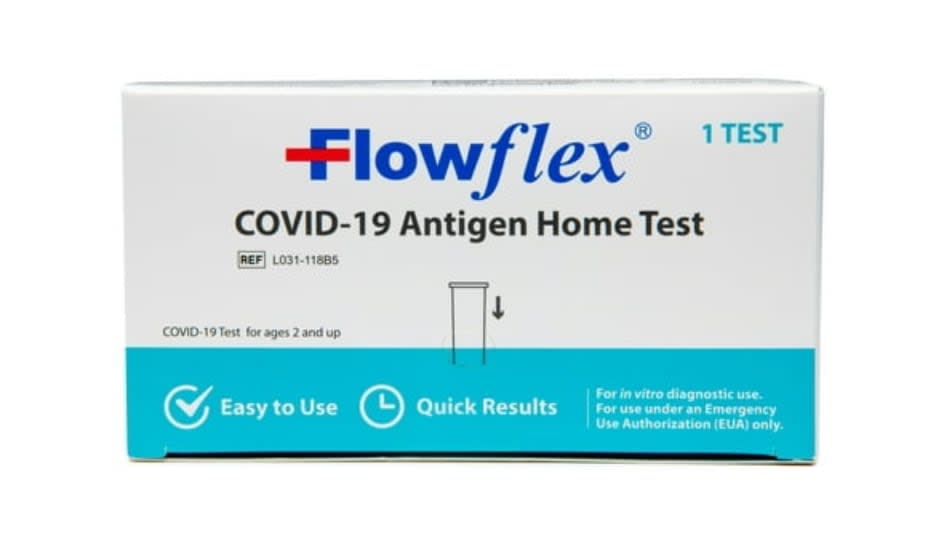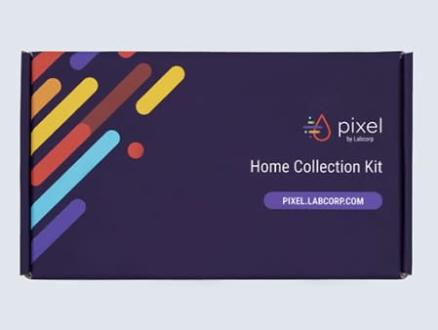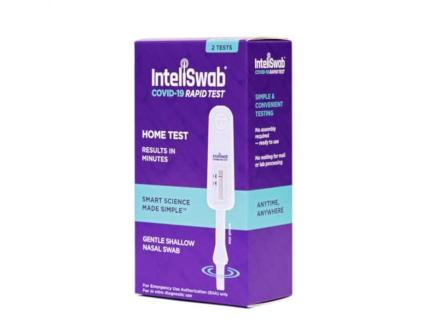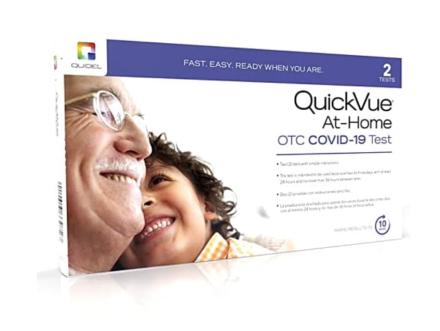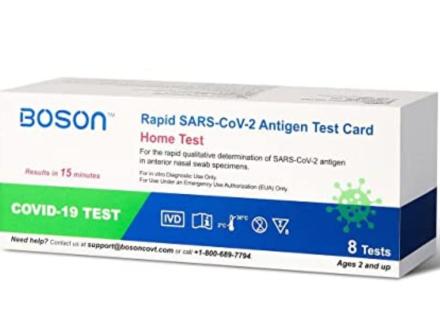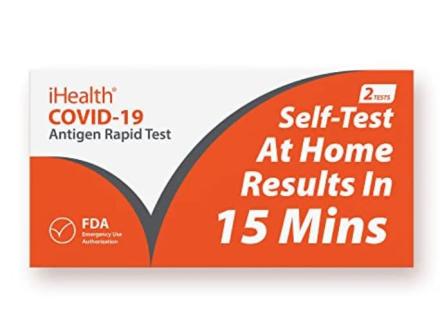With the latest XEC COVID variant making its rounds, it’s likely you or someone you know has had to take an at-home test recently. Thankfully tests are more available than they have been in months past, but there is still something to be said for choosing a test that’s easiest to use, with clear instructions that also provide accurate and speedy results.
With flu season, we also see a spike in respiratory diseases, such as the Respiratory Syncytial Virus (RSV). Since RSV and flu symptoms can closely mirror COVID symptoms — headache, cough, body aches, sore throat and congestion — having an at-home COVID test on hand is the fastest way to confirm whether or not COVID is the culprit.
At-home COVID tests, while generally easy to administer, are most definitely not one-size-fits-all and can vary widely by the number of steps it takes to administer the test, the ages the test is approved for, the time it takes to get results, and even how many tests are included in each testing kit. Currently, the FDA lists over forty emergency-use approved at-home COVID tests on its website from over thirty different brands. Some tests are rapid at-home antigen tests that give results in as little as 15 minutes, while other at-home tests are polymerase chain reaction (PCR) tests that require you to send the sample to the lab for screening. In general, PCR tests are more reliable, with an average accuracy rate of 95%, while at-home antigen tests have about an 80% accuracy rate. Above all, “It is important to only use FDA-authorized at-home COVID-19 tests,” said Dr. Minji Kang, an infectious disease specialist.
To help you find the optimal at-home COVID test for your needs, we spoke with four experts ranging from infectious disease specialists to family physicians about what to look for in a good test and any factors that improve reliability. Using our experts’ feedback, we then researched more than 42 at-home COVID tests and evaluated each on various criteria, such as cost, ease of use, collection method, the age the test is approved for, and the time it takes to receive the test results. Here are our picks for the best at-home COVID tests.
Table of contents
Update, Dec. 23, 2024: We checked all product prices and availability. Our number one pick for the best at-home COVID test remains unchanged.
Best overall at-home COVID test
Number of tests included: 1, 2 or 5 tests | Collection method: Nasal swab | Steps to results: 5 | Time to results: 15 minutes | Accuracy: 89.8% | PCR or antigen: Antigen | Shelf life: 12 months
The Flowflex COVID-19 Antigen Home Test is currently the first and only at-home COVID test cleared by the FDA’s premarket review pathway. So while all the tests on this list are cleared by the FDA as safe and effective for emergency use, this test has successfully passed rigorous testing and is approved and backed by the FDA’s gold standards. What’s more, the test proved to correctly identify 89.8% of positive and 99.3% of negative samples in individuals with signs and symptoms of upper respiratory infection. That said, it is important to note many other tests on this list may also reach this level of clearance after individual pathway reviews.
We also like that you can choose the number of tests you want in a kit ranging between one, two or five tests. It also has one of the longest shelf lives of the tests on this list at 24 months.
The test is easy to use, requiring five total steps starting with a simple nasal swab that is then dipped into a solution, swirled around a few times and then applied to the test card via a few drops of the mixed solution; results are ready in 15 minutes and easy to read thanks to a solid red line that appears when the test is positive. Another unique feature of the test is the box itself. There’s a perforated tube holder on the box, which makes the set-up and test collection process that much easier and mess-free, no need to worry about knocking over the solution or spilling the solution while holding and swirling the swab.
- First At-Home Covid test Cleared by FDA
- Very easy to use
- 24 month shelf life
- Not as accurate as a PCR test
Other top at-home COVID tests we recommend for 2025
Number of tests included: 1 | Collection method: Nasal swab | Steps to Results: 6 | Time to results: 1-2 days after lab receipt | PCR or antigen: PCR | Shelf life: Not clear
Even though the Pixel test by Labcorp is not a fully at-home COVID test – you have to mail your sample to the lab for processing – we would not be doing our due diligence if we left such a robust and groundbreaking test off this list, being that is the only at-home test of its kind to test for Flu, RSV, COVID at the same time with one simple self-administered test. Especially since Anthony Ognjan, a board-certified osteopathic physician specializing in infectious diseases, told us, “The new strains [of COVID] that are coming out are 10 to 20 times more contagious than the subsequent virus strains that [originally] devastated the world. They now affect the upper airways and no longer the lungs.” The virus is constantly evolving, so self-diagnosing according to your symptoms could be incredibly dangerous since COVID symptoms today mimic more closely to an upper respiratory illness, such as the flu or RSV. A test such as this one is the safest way to ensure you’ve pinpointed the cause of your illness, and thus can treat your symptoms accordingly.
This test is only available through the Labcorp website and will be shipped directly to your home within 24-48 hours after ordering. Once the test arrives, you’ll follow the directions to take the test, and then drop the sample in the mail using the prepaid postage packaging. You will receive your results electronically within 1-2 days of lab receipt.
- Detects COVID, Flu and RSV
- The only OTC test of its kind
- Regularly updates to screen for emerging variants
- Must send to Labcorp for results
Number of tests included: 2 | Collection method: Nasal swab | Steps to Results: 3 | Time to results: 30 minutes | PCR or antigen: Antigen | Shelf life: 24 months
Most at-home COVID tests are fairly easy to use, especially once you’ve taken a rapid test a few times, but when you’re not feeling so hot, mistakes can be made and even one extra step — like mixing the solution or adding a certain number of drops to a test reader — can feel overwhelming, not to mention it also allows for more room for error. With the rapid test from InteliSwab, that’s not an issue.
InteliSwab’s unique design makes it super simple to take the test, no matter how crappy you feel. The nasal swab is attached to the test device and the solution is already mixed and ready to go, meaning there are only three steps to the entire testing process, whereas some tests on this list require five or more steps. Swab your nose, put the swab in the solution tube, and then check your results in 30 minutes. We do want to point out that the tests’ swab is large and flat, so may be more uncomfortable than the long skinny swabs included with most tests, and may not be easy to use on little children (the test is approved for use in children as young as 2 years old) and the thirty-minute wait for results is almost double other at-home tests. So, with all that in mind, you’ll want to weigh the pros and cons of this test before purchasing.
- Solution is pre-mixed
- Only two testing components
- Very easy to administer
- Larger nasal swab than other tests
- Takes 30 minutes to see results
Number of tests included: 2 | Collection method: Nasal swab | Step to results: 4 | Time to results: 10 minutes | PCR or antigen: Antigen | Shelf life: 9-10 months
If patience is not one of your virtues, then the at-home COVID test from QuickVue is for you. Each pack comes with two swabs, two testing strips and two pre-filled solution vials, so there’s no mixing required. There’s also a tube holder to make it that much easier on you. Once you swab your nose, swirl it in the solution and then dip the paper testing strip into the tube. One possible downside is the paper test strip’s flimsy and somewhat messy process. Most of the other rapid tests use plastic cards similar to a pregnancy test stick, so using the paper strip can be a bit harder to get used to.
Still, with results ready in just 10 minutes, taking an extra 30 seconds to read the test strip is probably a fair trade-off.
- Results ready in 10 minutes
- FHA/HSA eligible
- More expensive than other tests
- Paper strip is harder to read than other test devices
Number of tests included: 1 | Collection method: Nasal swab | Steps to results: 5 | Time to results: 15 minutes | PCR or antigen: Antigen | Shelf life: 24 months
In addition to the Flowflex COVID-19 Antigen Home Test (our choice for best overall test) the On/Go COVID-19 antigen home test was also approved by the FDA for having a 24-month shelf life. The On/Go test kit includes one test per box, but can also be purchased in bulk for $80 for 12 test kits.
What sets this test apart is the On/Go app-guided testing process. You’ll first download the On/Go app and watch a video on how to take the test; then after taking the test, the app’s timing feature will alert you once the test is ready to read. You’ll use your phone or tablet’s camera to scan the test and QR code located on the test card. Depending on your results, the app will let you know if you are either positive or negative for COVID and what your next steps should be, if any.
- Results ready in 15 minutes
- Easy-to-use app can help guide the process
- Shelf-life of 24 months
- Only one test per pack
Number of tests included: 2 or 4 | Collection method: Nasal swab | Steps to results: 4 | Time to results: 15 minutes | PCR or antigen: Antigen | Shelf life: 15 months
BinaxNOW is another easily recognizable test due to being widely available in major retailers across the country and one of the test brands sent by the US government’s free COVID test initiative. The test is safe for use on children as young as two years old, with the results ready in 15 minutes. You can also purchase two or four tests in a single kit, so it’s perfect for a family of four, or to keep a few on hand, especially since there’s a 22-month shelf life!
This test does require a few more steps than other tests on this list, including adding an exact amount of drops to the test card, then a nasal swab of both nostrils for 15 seconds each, then dip the swab in the solution and swirl around before squeezing the excess off the swab before inserting the swab in the card, and last you will need to fold the card in half and seal shut. It’s important to be careful with this test, take your time and follow the instructions very closely so you can be sure to get accurate results.
Note: If you are a large family looking for the most cost-effective test, you may want to consider the Boson test which has eight tests for $27. The only drawback is that the test has the shortest shelf life of all the tests on our list at just 11 months.
- Shelf life of 22 months
- Quick results time
- Widely available at grocery stores and pharmacies
- Requires seven steps which is quite a bit more than other tests on this list
Number of tests included: 8 | Collection method: Nasal swab | Steps to results: 5 | Time to results: 15 minutes | PCR or antigen: Antigen | Shelf life: 6 months
If you find yourself having to test for COVID often, buying one or two tests at a time probably isn’t going to cut it, nor is it very cost-effective. Luckily, there’s the Boson Rapid Antigen Test, which comes with a whopping eight tests per pack.
Unlike most other rapid tests, with Boson’s, you’ll need to leave the swab in the solution for a full minute before adding the solution drops to the test card. Still, this doesn’t add much of a delay, though if you’re used to testing with other brands, it’s easy to miss this step. It’s also important to note the expiration date. Although it’s been given an extended shelf life by the FDA, at only 11 months, it’s still the shortest one on this list, but if you have to test frequently, the short shelf life shouldn’t be much of a concern. The easy-to-read results are ready within 15 minutes.
- Multiple tests in one pack
- Easy-to-read results
- Swab has to be left in the solution for 1-minute
- Shelf life is only 6 months
Number of tests included: 2 | Collection method: Nasal swab | Steps to results: 6 | Time to results: 15 minutes | PCR or antigen: Antigen | Shelf life: 15 months
One of the most popular at-home COVID tests, the iHealth Antigen Rapid Test’s bright orange box isn’t the only thing that helps make this rapid test a standout.
For starters, clear instructions are incredibly important and the iHealth test provides detailed step-by-step photo instructions with accompanying written descriptions — there’s also a video you can watch on the website. The test itself is also incredibly easy to administer: just a simple swab of both nostrils with the included swab, then dip the swab in the solution, swirl around and then add three drops of the solution (now mixed with your swab) to the test card and results are ready within 15 minutes. The results are clear-cut, with one or two lines denoting positive or negative.
This test is by far the most popular test ordered on Amazon with more than 155,000 5-star reviews. One reviewer said, “This is the only test I trust and it is very easy to use. Just be sure to squeeze the sides of the tube to get as much of the sample out of the swab.“
- Minimal steps for testing
- Easy-to-read results
- Widely available
- The testing solution is not always pre-mixed
Factors to consider when choosing an at-home COVID test
With so many rapid testing options on the market, figuring out which COVID test is right for you can be hard. Here are the factors to keep in mind:
-
Accuracy: Not all tests are created equally, especially regarding accuracy. While the Flowflex COVID-19 Antigen Home Test has FDA verification of accuracy at 89.8% of positive and 99.3% of negative samples, iHealth, for example, states a 94.3% accuracy rate shown during independent lab studies that have yet to be FDA-verified, while the Boson Rapid SARS-CoV-2 Antigen Test Card independent study lists the highest accuracy rate of 95.2%, but is also not yet FDA-verified.
-
Type of Test (PCR vs. Antigen): According to physician Dr. Laura Purdy, PCR tests are still the most reliable and accurate way to test for COVID. However, these tests must be sent to a lab for results, so they’re not very convenient or rapid and often costly. Antigen tests, on the other hand, offer results within 10-30 minutes.
-
Collection method (Saliva vs. Nasal swab): Most rapid tests are processed using a nasal swab, but a few use saliva instead. The P23 Labs test, for example, is a PCR test that analyzes saliva samples, but it’s not exactly rapid. Although the samples are collected at home, the sample still must still be mailed to a lab for processing, so results aren’t available immediately.
-
Testing process: Each test is administered a little differently. For example, some require you to mix the solution yourself, keep the swab inserted for a set amount of time, or add a certain number of drops to a card reader. Then there’s the process of getting your results. Rapid test results will be ready between 10 and 30 minutes. The interpretation is also different with each test – some have results that are clearer and easier to understand. All these factors are worth considering.
-
Number of tests: A single-use package is probably sufficient if you’re looking for a quick way to test yourself for COVID before an upcoming event or traveling and want to have a test on hand. But for those needing more than one test, look for brands offering multiple tests in each kit.
-
Expiration date: The shelf life of home tests can range from 4 to 24 months. For some, a long-lasting test may be unnecessary, but depending on your needs, you should keep a few tests in your medicine cabinet, and the shelf life is important to factor in when choosing a test you’re keeping on hand for emergencies. NOTE: The FDA has recently given several different brands extended expiration dates, so make sure to check the updated information.
-
Cost: Finally, consider how much each pack costs. Again, depending on how often you need to test, this factor might be more important to some.
COVID comes with a number of unpleasant symptoms, but certain symptoms require immediate medical attention, says Dr. Purdy. Symptoms to watch for include: difficulty breathing, eating, drinking, or staying awake, severe chest pain, confusion, or pale, blue, or gray skin, lips or nails.
According to Dr. Kang, those with certain underlying health conditions may want to contact a healthcare provider regardless. For some people, such as those with autoimmune disorders, heart disease and cancer, there’s a greater risk of developing severe COVID, so it’s a good idea to contact a doctor right away.
How we chose the best at-home COVID tests
To narrow down our list of best at-home COVID tests for various needs, we first spoke to medical experts and infectious disease specialists to get more insight into rapid COVID tests and how to choose the best one for various needs. We then researched 38 different FDA-approved at-home COVID tests and compared each based on accuracy, ease of use and results speed. Other factors we considered included cost, shelf life, number of tests per pack and user reviews.
At-home COVID test FAQs
Can rapid tests detect new variants?
According to both Dr. Kang and Dr. Purdy, yes, rapid tests can detect new variants of the virus. “However, there are no tests that tell you which variant you have,” Dr. Kang advises.
Are at-home COVID tests reliable?
While PCR tests are the gold standard in COVID detection, rapid tests do provide reliable results, with research suggesting that home tests are accurate approximately 80% of the time.
“With at-home antigen tests, positive results are usually accurate. However, a negative result may be inaccurate,” said Dr. Kang. Since false negatives can happen if you test yourself too soon, it’s recommended that you take a second test 48 hours later to be safe.
Other factors that can cause a false negative include having a low viral load, using an expired test or simply doing it wrong. “At-home tests are dependent on the tester,” Dr. Purdy said. “It’s important to follow the instructions on the test kit to ensure the most accurate results.”
How often can you get COVID?
While it’s different for everyone, reinfections are not uncommon. “Once you’ve had COVID-19, the immune response from your infection can protect you against reinfection for a few months, but this protection decreases with time,” said Dr. Kang.
As for exactly how often you can be infected, that too depends. Most doctors and health agencies say there’s a 90-day protection window, meaning you’re unlikely to get COVID twice within a three-month period. However, Dr. Kang noted that this guideline only accounts for the existing variants. “As the virus mutates, new variants can evade your existing immunity, increasing your risk of reinfection,” she told us. “So, reinfection within 90 days with two different variants is possible.”
Are at-home COVID tests covered by insurance?
In January 2022, the federal government declared COVID a public health emergency. Because of that, health insurance companies were required to cover the cost of up to eight at-home COVID tests per month. Unfortunately, that no longer applies since the public health emergency period ended in May of 2023, so many health plans aren’t covering home tests anymore. Luckily, you can still get a limited number of over-the-counter tests for free through the government.
How can I get a free COVID test?
If you live in the U.S., you can get four rapid COVID tests delivered for free through the COVIDTests.gov program. Each household is entitled to one order, which gives you four free at-home tests. Just visit https://www.COVID.gov/tests and follow the instructions.
Meet our experts
-
Minji Kang, an infectious disease specialist
-
Laura Purdy, board-certified Family Medicine Physician
-
Yvonne Covin, Internal medicine specialist and Primary Care Physician
-
Anthony Ognjan, Osteopathic physician specializing in infectious diseases

